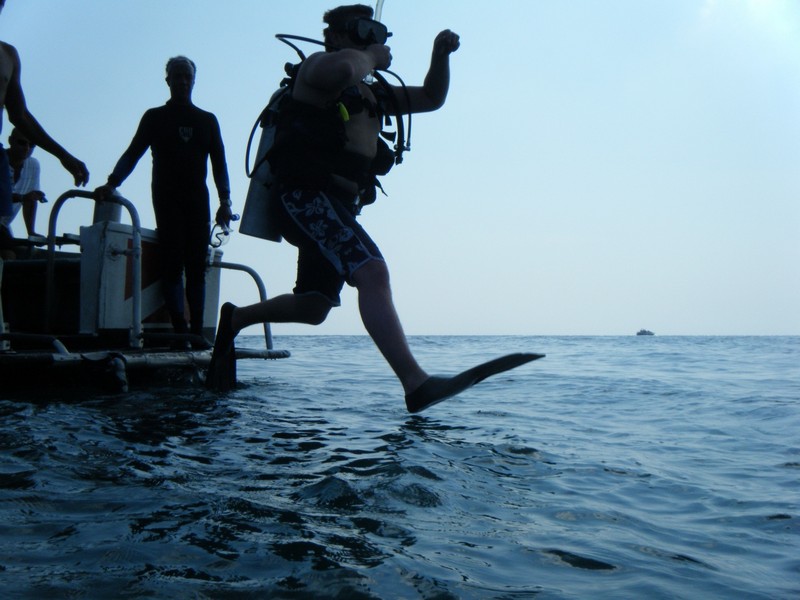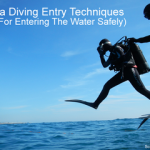
Two scuba diving techniques include: negative entry and using a downline.
A negative entry is a scuba diving technique where the diver enters the water without floating on the surface first. Using a downline scuba diving, on the other hand, is a scuba diving technique where a line is dropped from a boat or buoy to the desired dive site.
A negative entry is a scuba diving technique where the diver enters the water without floating on the surface first. Instead, the diver descends immediately upon entering the water, usually by rolling off the boat or jumping off the side of the boat. This technique is used to conserve air and reduce the amount of time spent on the surface before starting the dive.
Using a downline scuba diving, on the other hand, is a scuba diving technique where a line is dropped from a boat or buoy to the desired dive site. The divers then use the line to descend and ascend, following it to the dive site and using it as a guide throughout the dive. This technique is particularly useful when diving in strong currents or low visibility, as it allows the divers to maintain their orientation and avoid getting lost.
Both techniques have their advantages and disadvantages, and the choice of which to use will depend on the specific dive site and conditions. It’s important to note that both techniques require proper training and experience to execute safely and effectively. Scuba divers should always follow best practices and adhere to safe diving procedures to minimize the risk of injury or accidents.
What is a negative entry?
A negative entry is a technique used in scuba diving where the diver enters the water directly from the surface and descends immediately, without pausing or swimming horizontally on the surface.
The term “negative” refers to the fact that the diver is not positively buoyant, but rather is immediately descending toward the bottom of the dive site.
The most common types of negative entries are the backward roll and the controlled descent. In the backward roll, the diver sits on the edge of the boat, facing inward, and rolls backwards into the water while keeping the regulator in their mouth and the mask on their face.
The controlled descent involves a similar technique, but the diver uses their arms and legs to control their rate of descent and maintain control as they enter the water.
Negative entries are often used when diving in currents, as they allow the diver to quickly reach the desired depth and begin the dive without being swept away by the current.
They are also useful for minimizing the amount of time spent on the surface, conserving air and reducing the risk of sea sickness. However, negative entries require proper training and experience to execute safely, and should only be attempted by certified scuba divers who have been trained in the technique.
What is a dive line?
A dive line is a rope or line that is used as a guide for scuba divers during a dive. The line is usually anchored to a stationary object such as a boat, a buoy, or a weight on the bottom, and extends down to the dive site.
The purpose of the dive line is to provide a clear and visible path for divers to follow, allowing them to maintain their orientation and avoid getting lost in unfamiliar or low-visibility environments.
Dive lines can be particularly useful when diving in deep or murky waters, or when navigating complex underwater environments such as caves or wrecks. By following the line, divers can safely explore these areas while minimizing the risk of becoming disoriented or lost.
Dive lines may also be used to mark the ascent line during a safety stop, which is a mandatory stop made by divers during their ascent to allow the body to off-gas and release excess nitrogen absorbed during the dive. In this case, the line is used as a reference point to ensure that the divers are at the correct depth during the stop.
Dive lines come in a variety of materials and lengths, and may be marked with tags or other indicators to help divers navigate. It’s important for divers to receive proper training and follow safe diving procedures when using a dive line, to minimize the risk of injury or accidents.
What is a downline in diving?
In scuba diving, a downline refers to a rope or line that is used to guide the divers during descent and ascent. The line is usually anchored to a stationary object such as a boat, a buoy, or a weight on the bottom, and extends down to the dive site.
To use a downline, divers typically descend along the line, using it as a guide to control their rate of descent and maintain their orientation. Once they reach the bottom, they can use the line as a reference point for the duration of the dive, allowing them to explore the site while remaining aware of their position.
During ascent, divers can follow the line back to the surface, using it as a reference point to ensure that they ascend at a safe and controlled rate. The line can also be used to mark the ascent line during a safety stop, which is a mandatory stop made by divers during their ascent to allow the body to off-gas and release excess nitrogen absorbed during the dive.
Downlines are particularly useful when diving in strong currents, low visibility, or complex underwater environments, as they allow divers to maintain their orientation and avoid getting lost. However, they require proper training and experience to execute safely and effectively, and should only be attempted by certified scuba divers who have been trained in their use.
To discover more about liveaboard diving, please scroll through this list of dive liveaboards from around the world:
I hope you enjoyed this article about negative entry vs using a downline
I’d love to hear from you. Tell us about your adventures of diving and snorkeling, in the comments below. Please also share your photos. Either from your underwater cameras or videos from your waterproof Gopro’s!
If this article hasn’t answered all of your questions. If you have more questions either about snorkeling or scuba diving (or specifically about negative entry vs using a downline), please comment below with your questions.
There will also be many more articles about scuba diving (and snorkeling) for you to read and learn about these fabulous sports.
Have fun and be safe!





